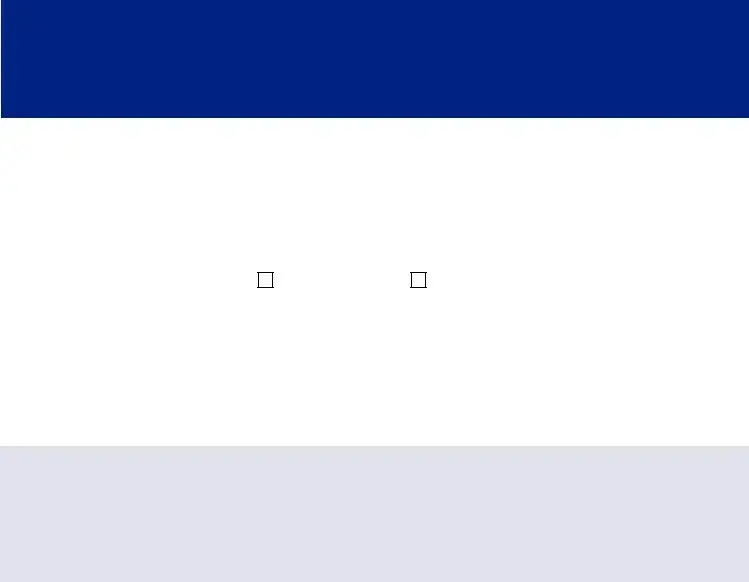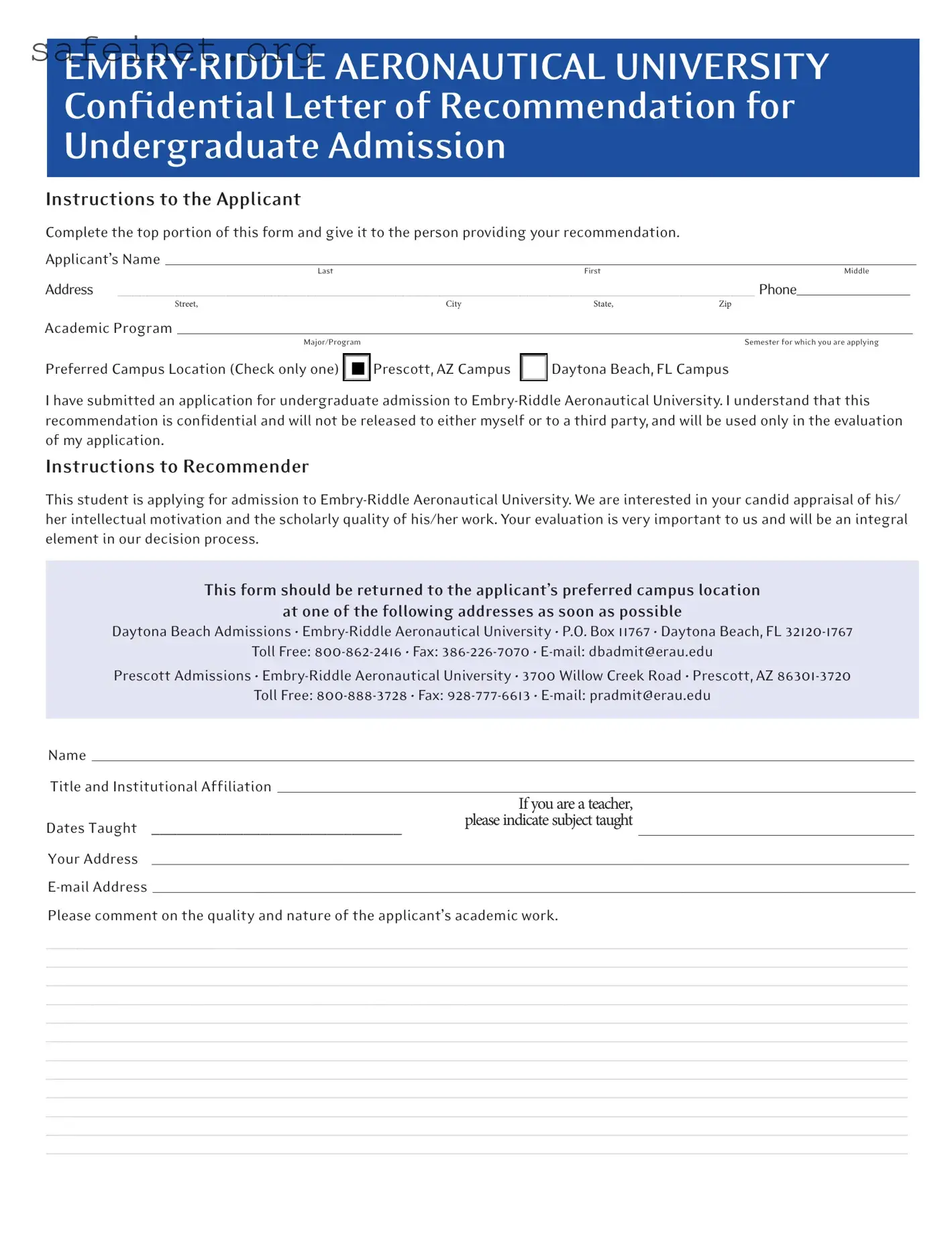
EMBRY-RIDDLE AERONAUTICAL UNIVERSITY Confidential Letter of Recommendation for Undergraduate Admission
Instructions to the Applicant
Complete the top portion of this form and give it to the person providing your recommendation.
Applicant’s Name___________________________________________________________________________________________________________________________________________
|
Last |
|
First |
Middle |
Address |
_______________________________________________________________________________________ Phone_____________________ |
|
Street, |
City |
State, |
Zip |
Academic Program ________________________________________________________________________________________________________________________________________
Major/Program |
Semester for which you are applying |
Preferred Campus Location (Check only one) n Prescott, AZ Campus |
n Daytona Beach, FL Campus |
I have submitted an application for undergraduate admission to Embry-Riddle Aeronautical University. I understand that this recommendation is confidential and will not be released to either myself or to a third party, and will be used only in the evaluation of my application.
Instructions to Recommender
This student is applying for admission to Embry-Riddle Aeronautical University. We are interested in your candid appraisal of his/ her intellectual motivation and the scholarly quality of his/her work. Your evaluation is very important to us and will be an integral element in our decision process.
This form should be returned to the applicant’s preferred campus location
at one of the following addresses as soon as possible
Daytona Beach Admissions • Embry-Riddle Aeronautical University • P.O. Box 11767 • Daytona Beach, FL 32120-1767
Toll Free: 800-862-2416 • Fax: 386-226-7070 • E-mail: [email protected]
Prescott Admissions • Embry-Riddle Aeronautical University • 3700 Willow Creek Road • Prescott, AZ 86301-3720
Toll Free: 800-888-3728 • Fax: 928-777-6613 • E-mail: [email protected]
Name ________________________________________________________________________________________________________________________________________________________
Title and Institutional Affiliation ______________________________________________________________________________________________________________________
|
|
If you are a teacher, |
Dates Taught |
______________________________ |
please indicate subject taught ___________________________________________________ |
Your Address |
____________________________________________________________________________________________________________________________________________ |
E-mail Address _____________________________________________________________________________________________________________________________________________
Please comment on the quality and nature of the applicant’s academic work.
_________________________________________________________________________________________________________________
_________________________________________________________________________________________________________________
_________________________________________________________________________________________________________________
_________________________________________________________________________________________________________________
_________________________________________________________________________________________________________________
_________________________________________________________________________________________________________________
_________________________________________________________________________________________________________________
_________________________________________________________________________________________________________________
_________________________________________________________________________________________________________________
_________________________________________________________________________________________________________________
_________________________________________________________________________________________________________________
_________________________________________________________________________________________________________________
How would you describe this student? Are there any personal strengths, weaknesses, or problems of which you feel we should be aware?
__________________________________________________________________________________________________________________
__________________________________________________________________________________________________________________
__________________________________________________________________________________________________________________
__________________________________________________________________________________________________________________
__________________________________________________________________________________________________________________
__________________________________________________________________________________________________________________
__________________________________________________________________________________________________________________
__________________________________________________________________________________________________________________
__________________________________________________________________________________________________________________
__________________________________________________________________________________________________________________
__________________________________________________________________________________________________________________
__________________________________________________________________________________________________________________
|
Below |
Average |
Good |
Very Good |
Excellent |
One of the Top |
|
Average |
|
(above average) |
(well above average) |
(top 10%) |
Few in My Career |
|
|
|
|
|
|
|
Creative original thought |
|
|
|
|
|
|
|
|
|
|
|
|
|
Motivation |
|
|
|
|
|
|
|
|
|
|
|
|
|
Perseverance |
|
|
|
|
|
|
|
|
|
|
|
|
|
Independence initiative |
|
|
|
|
|
|
|
|
|
|
|
|
|
Intellectual ability |
|
|
|
|
|
|
|
|
|
|
|
|
|
Academic achievement |
|
|
|
|
|
|
|
|
|
|
|
|
|
Written expression of ideas |
|
|
|
|
|
|
|
|
|
|
|
|
|
Effective class discussion |
|
|
|
|
|
|
|
|
|
|
|
|
|
Disciplined work habits |
|
|
|
|
|
|
|
|
|
|
|
|
|
Potential for growth |
|
|
|
|
|
|
|
|
|
|
|
|
|
Summary Evaluation |
|
|
|
|
|
|
|
|
|
|
|
|
|
dditional Comments
______________________________________________________________________________________________________________________________________________________________
_____________________________________________________________________________________________________________________________________________________________
______________________________________________________________________________________________________________________________________________________________
______________________________________________________________________________________________________________________________________________________________
______________________________________________________________________________________________________________________________________________________________
______________________________________________________________________________________________________________________________________________________________
Signature___________________________________________________________________________________ Date_________________________________________________________
Confidentiality:This form will be retained in the student’s file should the student matriculate. In accordance with the Family Educational Rights and Privacy Act of 1974, matriculating students do have access to their permanent files, which may include such forms as this. Embry-Riddle Aeronautical University does not provide access to admissions records to applicants, students who are denied admission or students who decline an offer of admission. The University’s policies may be of assistance to you as you complete this form. Many thanks for your comments and assistance.


